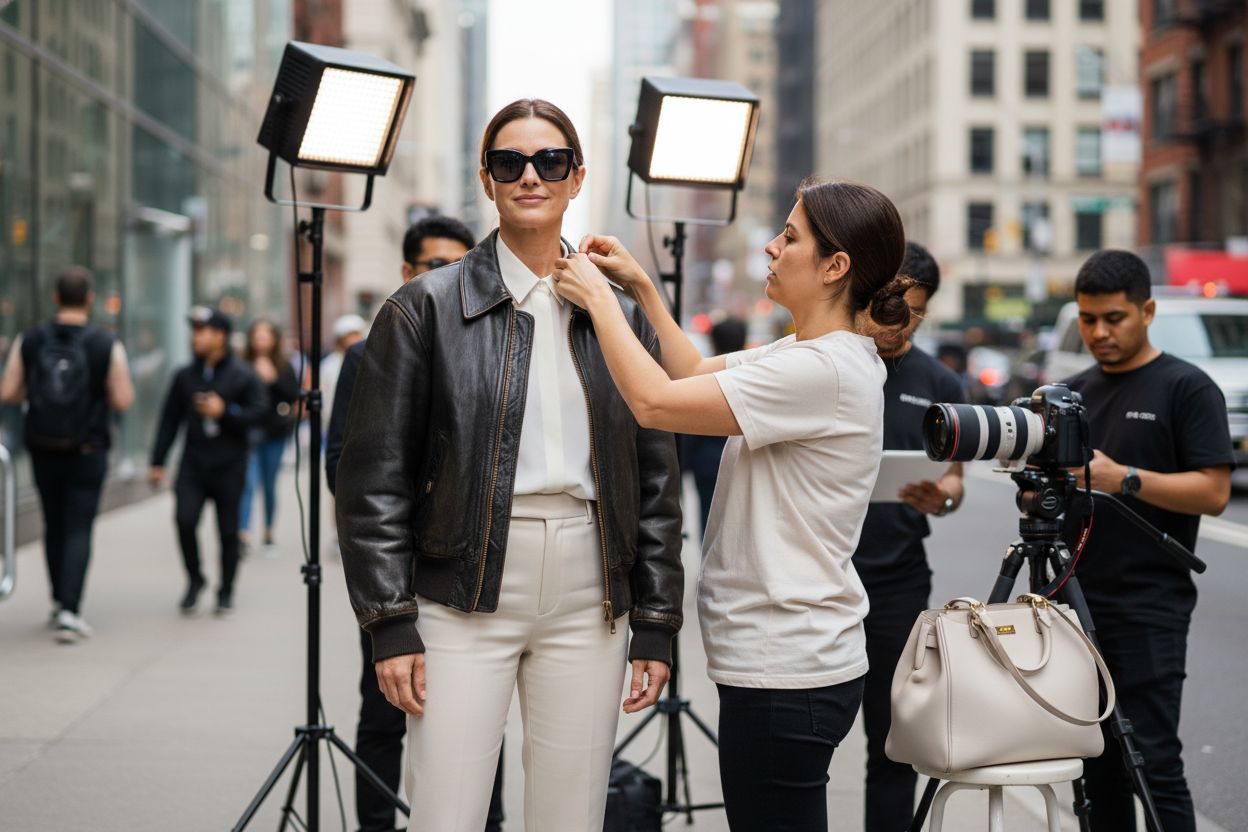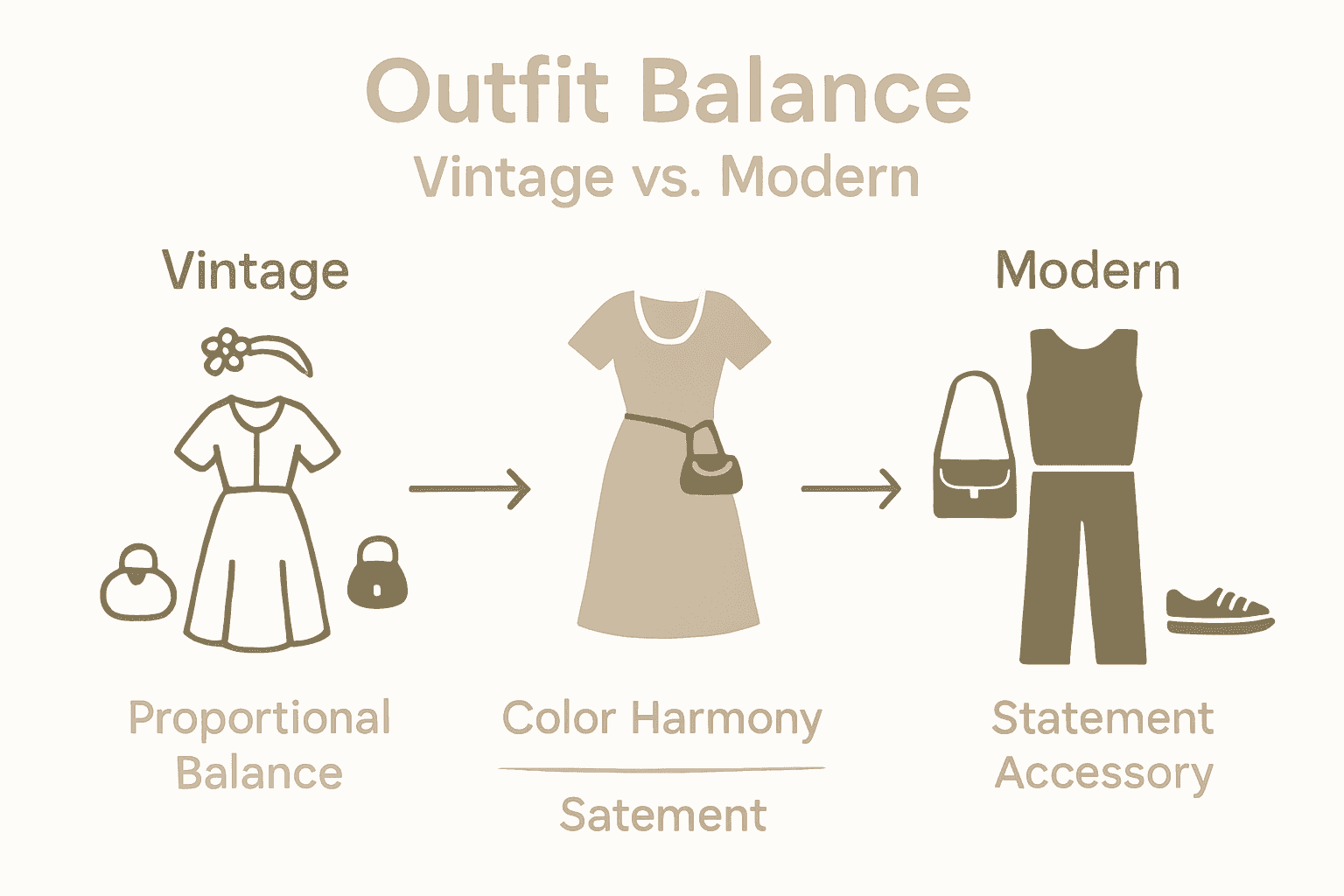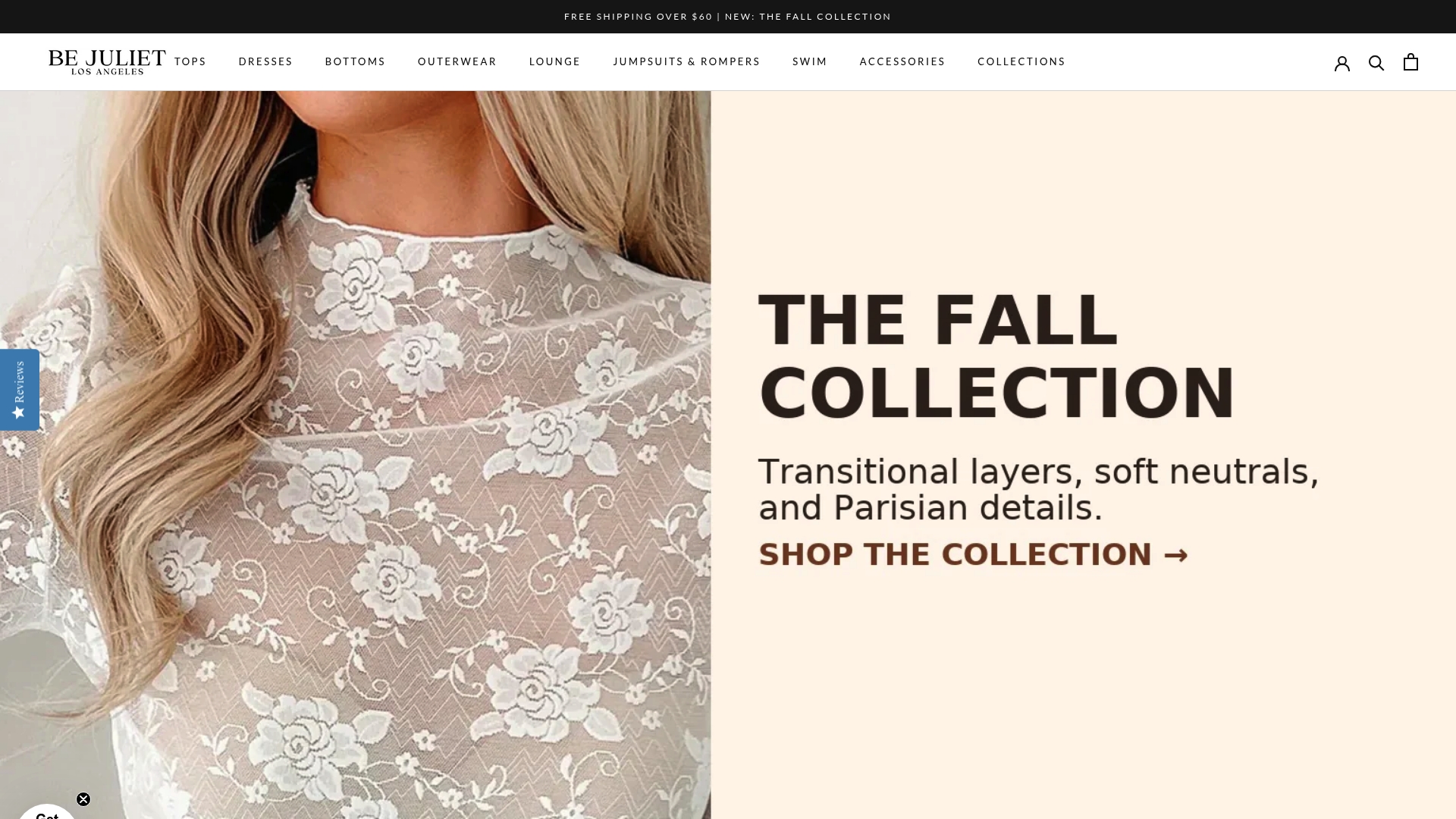Mixing Old and New: Complete Guide to Timeless Style
Did you know that nearly 70 percent of trendsetters now rely on mixing old and new styles to define their look? This creative approach invites endless possibilities whether you treasure vintage finds or crave the latest trends. By blending iconic pieces from different eras with modern touches, you craft a wardrobe that feels personal and fresh. Discover how this mix brings character, confidence, and a unique story to every outfit you wear.
Key Takeaways
| Point | Details |
|---|---|
| Mixing Styles Intentionally | Blending old and new styles is an art that requires a cohesive approach, focusing on balance and visual interest. |
| Focus on Color and Texture | Establishing a consistent color palette and utilizing varied textures are crucial for creating harmony between vintage and modern pieces. |
| Learn from Fashion Icons | High-profile figures exemplify the art of mixing eras, demonstrating that personal style transcends rigid fashion rules. |
| Avoid Common Pitfalls | Stay mindful of proportional balance and avoid over-theming to prevent outfits from feeling disjointed or costume-like. |
Table of Contents
- Defining Mixing Old And New Styles
- Key Types: Vintage Meets Modern
- How To Balance Contrasting Elements
- Inspiration From Real World Icons
- Common Mistakes And What To Avoid
Defining Mixing Old and New Styles
Fashion is a language of personal storytelling, and mixing old and new styles is like crafting a dynamic narrative where vintage whispers meet contemporary confidence. Transitional style isn’t just about throwing together random pieces—it’s an intentional art of blending historical charm with modern sensibilities.
According to research on transitional style, this approach emphasizes clean lines, neutral color palettes, and varied textures that create a refined fusion of historic and contemporary aesthetics. Think of it like composing a visual symphony where each piece—whether from your grandmother’s closet or the latest runway—plays a harmonious role.
Key characteristics of mixing old and new styles include:
- Balancing proportions between vintage and modern pieces
- Creating visual interest through unexpected combinations
- Respecting the individual character of each clothing item
- Maintaining a cohesive color narrative
Interestingly, the global fashion scene has embraced this concept through Newtro culture, which originated in South Korea. As documented in cultural research, Newtro isn’t about exact historical replication but rather a modern interpretation of retro aesthetics—particularly drawing from 1980s and 1990s influences. This approach transforms nostalgic elements into fresh, contemporary expressions.
At its core, mixing old and new is about personal confidence. It’s not following rules, but breaking them with intention. Your wardrobe becomes a canvas where different eras and styles dance together, telling a story that is uniquely, beautifully you.
Key Types: Vintage Meets Modern
Mixing vintage and modern styles is an art form that goes beyond simply combining old and new pieces. Vintage design represents a nuanced world where fashion becomes a time-traveling conversation between different eras, each piece telling its own unique story.
According to research on vintage design, true vintage items are typically between 40 and 100 years old, carrying significant design value. This distinction matters—vintage isn’t just ‘old,’ it’s carefully curated history. We’re not talking about your grandmother’s dusty sweater, but pieces that have stood the test of time and style.
The spectrum of vintage meets modern includes several fascinating approaches:
- Classic Vintage: Genuine pieces from specific historical periods
- Retro-Inspired: Modern designs that reference past aesthetics
- Reinterpreted Classics: Contemporary takes on traditional silhouettes
- Curated Nostalgia: Intentional mixing of era-specific elements
Here’s a comparison of popular approaches to mixing vintage and modern styles:
| Approach | Time Period Referenced | Main Characteristics |
|---|---|---|
| Classic Vintage | 1920s–1980s | Genuine era pieces Distinct historical feel |
| Retro-Inspired | 1950s–1990s motifs | Modern designs Nostalgic details |
| Reinterpreted Classics | Various (revamped) | Contemporary spins Traditional silhouettes |
| Curated Nostalgia | Multi-era | Blended elements Intentional mixing |
Retro style adds another fascinating layer to this fashion narrative. It’s about creating new designs that consciously reference past modes and motifs, evoking an unsentimental nostalgia. Think of it as a modern remix—taking the best of past decades and transforming them into something fresh and exciting.
Ultimately, mixing vintage and modern is about personal expression.
 It’s not following rules, but creating a style that’s uniquely yours—where a 1970s leather jacket might perfectly complement a sleek, contemporary silk blouse. Your wardrobe becomes a personal museum, each piece a carefully chosen artifact in your style journey.
It’s not following rules, but creating a style that’s uniquely yours—where a 1970s leather jacket might perfectly complement a sleek, contemporary silk blouse. Your wardrobe becomes a personal museum, each piece a carefully chosen artifact in your style journey.
How to Balance Contrasting Elements
Balancing vintage and modern styles isn’t about creating a perfect museum display—it’s about crafting a dynamic dialogue between different design languages. Style harmony emerges when you understand how to make contrasting elements speak to each other with intention and creativity.
According to design recommendations, creating a consistent color palette serves as the critical foundation for blending contrasting styles. This doesn’t mean everything must match exactly, but rather that colors should create a visual conversation that feels intentional and cohesive.
Key strategies for balancing contrasting fashion elements include:
- Establishing a clear visual focal point
- Playing with complementary textures
- Using neutral tones as a unifying backdrop
- Incorporating strategic accessories that bridge different styles
- Maintaining proportional balance between vintage and modern pieces
When mixing contrasting styles, think of your outfit as a curated art piece. A vintage silk scarf can dramatically transform a minimalist contemporary outfit, while a sleek leather jacket can add edge to a romantic, vintage-inspired dress.
The magic happens in those unexpected combinations that reveal your unique personal style.
Remember, the goal isn’t perfect symmetry but creative tension. Your wardrobe should feel like a living, breathing reflection of your personality—where different eras, textures, and design philosophies coexist in beautiful, imperfect harmony.

Inspiration from Real World Icons
Fashion icons are the ultimate storytellers, transforming clothing into a powerful language of personal expression. They show us that mixing vintage and modern isn’t just a trend—it’s an art form that transcends time and traditional style boundaries.
According to celebrity style research, high-profile figures like Zendaya, Rihanna, Taylor Swift, and Timothée Chalamet have masterfully demonstrated how to merge vintage inspirations with contemporary design. They prove that true style is about blending eras, not rigidly adhering to them.
Real-world icon examples showcase brilliant mixing strategies:
- Pairing classic silhouettes with unexpected modern accessories
- Using vintage pieces as statement elements in contemporary outfits
- Reimagining historical fashion through a current lens
- Creating unexpected dialogues between different fashion decades
Take actress Laura Harrier’s iconic look, for instance. As documented in fashion publications, she brilliantly combined a minimalist 90s top-handle bag with a vintage Alaïa minidress and modern Manolo Blahnik heels—demonstrating how carefully curated contrasts can elevate an entire ensemble. This approach isn’t about perfection, but about confident, creative self-expression.
These style mavens remind us that fashion is deeply personal. Your wardrobe is your autobiography, with each piece representing a chapter of your unique journey. Mixing old and new isn’t just about clothes—it’s about telling your story, one beautifully unexpected combination at a time.
Common Mistakes and What to Avoid
Mixing vintage and modern styles sounds romantic in theory, but in practice, it’s a delicate dance that can quickly turn into a fashion faux pas. Style integration requires strategic thinking and a keen eye for balance, understanding that not every combination works just because it sounds interesting.
According to vintage design research, one of the most common pitfalls is over-theming—creating an ensemble that feels more like a costume than a curated look. This happens when you accumulate too many vintage pieces without a unifying perspective, making your outfit feel like a museum display rather than a personal style statement.
Key mistakes to watch out for include:
- Ignoring proportional balance between vintage and modern pieces
- Selecting low-quality modern materials that clash with vintage aesthetics
- Forcing combinations that don’t have a natural visual dialogue
- Overlooking the importance of cohesive color palettes
- Treating vintage pieces as novelties instead of legitimate fashion elements
Lighting and presentation matter more than most realize. Just as harsh modern fixtures can disrupt a vintage room’s ambiance, inappropriate styling can make vintage pieces look dated instead of timeless. The goal is creating a seamless narrative where each piece—whether from this decade or a past one—feels intentional and personal.
Remember, mixing styles is an art of nuance. Your wardrobe should tell your story, not read like a disconnected anthology. Trust your instincts, but also be willing to edit ruthlessly—sometimes less truly is more when crafting a sophisticated, era-defying look.
Transform Your Wardrobe with Confidence and Love
If you have ever struggled with balancing vintage treasures and modern essentials, or worried your outfits might look costume-like instead of authentically stylish, you are not alone. This guide to mixing old and new styles highlights how hard it can be to create harmony between historic charm and contemporary flair, especially when trying to reflect your unique self. At Be Juliet, we understand these challenges and celebrate your desire for personal expression. Our collections are designed to help you blend the artistry of transitional style, curate pieces with timeless beauty, and make effortless connections between eras.

Do you want your wardrobe to tell your story and uplift your spirit every day? Visit Be Juliet to explore garments that honor history, embrace comfort, and infuse your look with the language of love. Start your journey today and discover versatile pieces designed for courage, elegance, and modern femininity. Your next era-defying ensemble is waiting—express yourself now with Be Juliet.
Frequently Asked Questions
How can I effectively mix vintage and modern styles?
To effectively mix vintage and modern styles, establish a clear visual focal point, play with complementary textures, and use a cohesive color palette to create visual harmony. Incorporating strategic accessories can bridge different styles, making the ensemble feel intentional and curated.
What are the key characteristics of transitional style in fashion?
Transitional style emphasizes clean lines, neutral color palettes, and varied textures that create a refined fusion of historic and contemporary aesthetics. It involves balancing proportions between vintage and modern pieces while respecting the individual character of each clothing item.
What common mistakes should I avoid when mixing old and new fashions?
Common mistakes include ignoring proportional balance, selecting low-quality modern materials that clash with vintage aesthetics, and creating an overly themed look that resembles a costume. Maintaining a cohesive color palette and treating vintage pieces as legitimate fashion elements is essential to achieving a sophisticated mix.
What is the significance of Newtro culture in fashion?
Newtro culture is a modern interpretation of retro aesthetics, particularly drawing influences from the 1980s and 1990s. It emphasizes blending nostalgic elements into fresh, contemporary expressions, allowing individuals to mix old and new styles in a way that feels innovative rather than exact historical replication.
